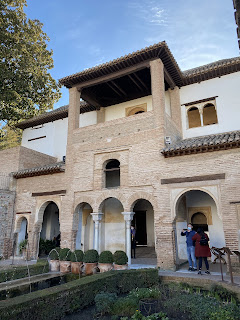What is so famous about Granada? Let me try to give you an extremely short snapshot history lesson. Most people who come to Granada come to see the Alhambra, the royal city of the Emirate of Granada, established by Muhammad I lbn al-Ahmar, the first ruler of the Nasrid dynasty. From the year 1237 until 1492, the Alhambra contained the longest dynasty of the Moors in this area.
The Moors had settled in the Iberian Peninsula in 711 and beginning in Toledo had spread out across the area. As they conquered more and more of the peninsula, they also began to fight among themselves and divided into smaller kingdoms. Muhammad I declared himself Emirate of Granada and began construction of his city and palace in 1238. Over the course of two centuries with his descendants, more palaces were added and the entire royal city expanded. The completed Alhambra contained 6 palaces and many towers along the fortress wall which sat atop the hill overlooking the city of Granada.
In 1492, yes, the same year that Christopher Columbus sailed the Atlantic, King Ferdinand conquered the rest of the Iberian Peninsula. Muhammad XII simply “handed over the keys” to the Alhambra and left the city. King Ferdinand and Queen Isabella took up residence for a time in the Nasrid Palaces following their midnight wedding in Cordoba, as part of their multi-year honeymoon. But it wasn’t until 1526, that King Charles I demanded that the palaces look more like the rest of the Renaissance era in architecture. So the walls were stuccoed over, much of the moorish style was covered up and a new palace and the construction of a Christian Cathedral was begun - neither was ever finished. By the 17th Century Spain could no longer afford them. In fact, several of the original Nasrid Palaces were dismantled and sold off to help pay for other construction work going on throughout Spain. Between 1810 and 1812 Napoleon’s army occupied the area and tried to bomb the entire Alhambra as they retreated so that it could not be used as a stronghold. They succeeded in destroying most of the remaining palaces and towers that fortified the wall. A Spanish soldier by the name of Jose Garcia stopped them from bombing the 2 northernmost palaces and 8 of the towers which remain today. For the next 100 years, the Alhambra remained in the hands of the locals and declined in upkeep, until 1829 when an American novelist, Washington Irving, came across the Alhambra during his years of exploration of southern Spain. He lodged for a time in the Alhambra and penned one of his most famous writings, Tales of the Alhambra. After the book was published and became an instant hit, the Spanish government, recognizing what they had, began restoring what was left.
I took over 200 photographs of my tour today. I’ll try to only give you a sampling. As you saw from yesterday’s post, the Alhambra sits on the hill overlooking the city of Granada. I hiked up that hill early this morning. Google Maps suggested that it should take 30 minutes. I gave myself just over an hour and I barely made it on time! Thankfully most of the walk was dotted with benches to rest. Although the climb took a lot of cardio to climb, the walk down was much harder on my knees and by the end of the walk, I didn’t know which knee hurt more, my “bad” knee or my “good” knee.
Today’s tour was a group tour not a private tour, so the information above I had to learn more about on my own. I knew that we’d tour the Alhambra, which is the entire complex and then specifically, the two Nasrid Palaces that remain and something that I thought was called the GeneralLife. I was mistaken - it’s called Generalife, which is a construct of two words, but not what it looks like it might be in English. In Arabic - genera, which we were told means garden and alife, which means God. So together it means, the Garden of God.
Side note: the name of my dessert the other day was called, Bomba de Natal, not what I had earlier thought it was.
Here’s a map of the royal city.











































No comments:
Post a Comment